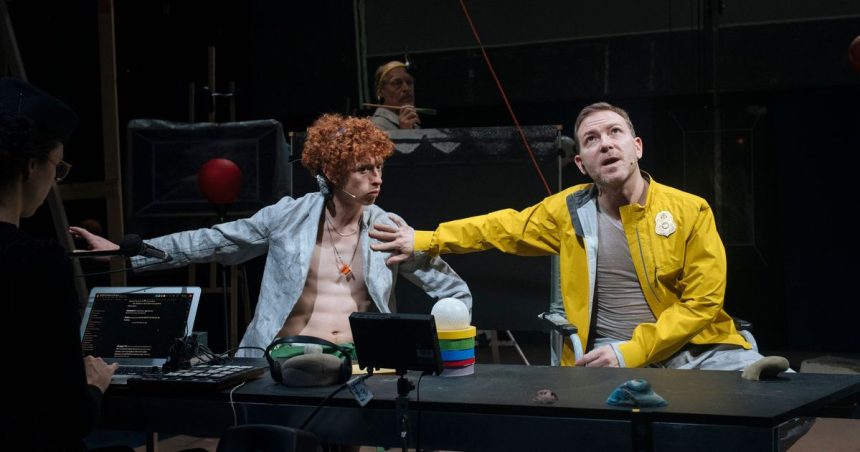Niall Cunningham, Ari Fliakos, and Jim Fletcher in the Wooster Group’s production of Richard Foreman’s Symphony of Rats.
Photo: Spencer Ostrander
Richard Foreman’s Symphony of Rats and I were born under the same president, a man with an easy drawl and a shiny grin, a background in performance and slate of policies fueling the machine that’s still—like some kind of fascist tugboat—pulling the country’s political center ever-rightward. When Ronald Reagan left office in 1989, he was, at 77, the oldest a departing president had ever been. But his ghost (may he be wandering the world dragging a chain of his own forging) won’t hold that record for much longer. Biden’s about to steal it, either at 82 or, some lesser devil willing, 86. What a grim thing to be hoping for.
When I say that those were some of the thoughts rattling through my head while watching the Wooster Group’s new production of Foreman’s surreal meditation on power, imagination, and other human absurdities, I don’t mean to imply that the show is a dour intellectual slog. Quite the opposite. Truthfully, I was grinning like a kid at the circus for most of the heady 75 minutes of Symphony of Rats. That might be partly because it’s a wild feeling to share a space with so many legends: Foreman’s Ontological-Hysteric Theater and the Wooster Group, still led by the inimitable Elizabeth LeCompte, have been keeping American theater weird for almost half a century. The walls of the Performing Garage have listened in as Richard Schechner (who was, incidentally, two seats down from me) and the Performance Group developed Dionysus in 69; as LeCompte—along with Kate Valk and Ron Vawter, Willem Defoe and Spalding Gray—threw Arthur Miller, Chekhov, Racine, Flaubert, and O’Neill into various blenders, wired them up, added Lenny Bruce, LSD, and badminton, shook hard, and served them to audiences with a twist. Now, the Wooster Group’s next door neighbors are Zara and Patagonia, so it matters—it really matters—that behind the Performing Garage’s unobtrusive brick façade, the theatrical avant garde is still fucking shit up as gleefully as ever.
“Don’t have a mind, be mind,” says a rat to the president of the United States: That’s about as straightforward as things get in Symphony of Rats. I wrote recently about Foreman’s lifelong project of frustrating “the commonplace drive toward narrative understanding,” his quest for a theater of “multidirectional impulses and collisions” rather than a theater of character, plot, or empathy (“which I hate,” Foreman has said. “Don’t identify with a character trying to achieve something”). As co-directors of this new playing of Foreman’s Symphony, LeCompte and Kate Valk keep the collisions constant and giddy: The dramatic architecture feels, as the rat said, like an attempt to theatricalize the chaos of the brain. Neurons fire, voices external and internal whisper and wail, stupid old movies you saw ages ago suddenly pop up while you’re thinking about death, or what to make for dinner, or whether aliens exist. The pinball rockets around the machine; things flash and buzz and distract and delight and devastate you, and you just try to keep walking around in your meat sack, acting like all this makes some kind of sense.
Or, if you’re the president, as envisioned by Foreman and here played with virtuosic precision by Ari Fliakos, you’re mostly wheeled around in a chair designed to allow for its inhabitant’s incontinence. At the risk of treachery—for describing Symphony in anything like linear terms—the president is “receiving messages by means other than the known senses.” Is he hearing voices from outer space? Is he trapped inside his own crumbling psychological labyrinth? His body certainly seems to be breaking down — as his assistants (Niall Cunningham and Andrew Maillet) roll him around; or as he’s subjected to various strange scans and tests; or as he nonchalantly unbuttons the back of his trousers to present the scuttling supernumeraries around him with stool samples, a creepily familiar picture forms. It’s an image of power that just keeps aging, its life extended by nearly infinite resources, its death delayed and delayed, even as its mind comfortably unravels, even as the “the end of our world approaches.”
As unsettling as the portrait is, and for all Foreman’s distaste for empathy, it’s not a cold one. In a prologue added to the original play text, Fliakos—as himself—tells us that the show “is about the president of the United States as someone no different from the rest of us: a mixed-up, stupid, fallible person bounced back and forth by forces outside his control.” Later, in a voiceover, he asks: “Suppose we had a president who allowed their imagination to function full-time. Would they be able to make the straight-ahead decisions they’re expected to?” There’s a deceptive normalcy about Fliakos’s appearance — he could easily walk onto Law & Order as any regular guy at the local bar or on the construction site where the victim’s body was found, but he can manipulate his voice and body with a musician’s sense of pitch, agility, and accuracy. Through him, we get the nuanced buffoonery of Foreman’s commander in chief, the haplessness, the mental drift, the menace. The guy thumb-tacking strings to the wall is funny until he’s also the one with the nuclear codes — but on the other hand, how might the world be different with leaders who thought and felt a little more like avant-garde artists?
I can’t tell you exactly what happens to the president — he might take a pill from a bodiless woman who may or may not be some kind of alien or sentient AI, and that pill might or might not transport him to another planet. He’ll definitely hold several conversations with a talking rat who, as embodied by the fabulously strange and sonorous Jim Fletcher, feels like a cross between Doc Brown and Nosferatu. He’ll watch clips from Ghost Ship and participate in a reenactment of “dialogue from D. H. Lawrence’s strange and passionate novel Women in Love.” Fliakos and Cunningham mimicking Ken Russell’s 1969 film beat for beat while LeCompte and Valk layer their mannered, homoerotic recitation on top of footage from The Suicide Squad of John Cena and Joel Kinnaman beating each other to a pulp is one of the funnier things I’ve seen onstage recently… in close competition with a later re-creation of the Han Solo–in–carbonite scene by Fliakos and the serpentine Michaela Murphy.
Mr. President will also dance and sing—Suzzy Roche wrote new songs for this production—and confer with an oracular figure who sounds like the be-all-end-all of action movie trailer narrators (Guillermo Resto’s voice already has more gravel in it than a quarry, and he and his fellow performers are also getting assist after assist from Eric Sluyter’s marvelously complex sound design). Mostly, Fliakos and the rest of Symphony’s brilliantly nimble ensemble will create a kind of porous, playful thinking space. This is theater that wants your mind to wander, and that effervescent sense of freedom is why, despite the ominous, even apocalyptic, nature of some of its musings, Symphony of Rats is experientially a delight. The point isn’t to put you on the kind of ride where you’re strapped in and trundled along a single track, but to release you into a state of heightened presence and free association. It’s mental jazz, both feral and meticulous. To quote the rat: “And the doorknob of my imagination said, hold me, I LIKE the twists and turns.”
Symphony of Rats is at the Performing Garage through May 4.












